
Kelp frond showing pneumatocysts.
Species: Giant kelp, Macrocystis pyrifera
Location: San Clemente Island, California
Image ID: 00627
Species: Giant kelp, Macrocystis pyrifera
Location: San Clemente Island, California
Image ID: 00627

Brown booby flying over Rose Atoll at sunset, with dark colorful storm clouds and other birds in the background.
Species: Brown booby, Sula leucogaster
Location: Rose Atoll National Wildlife Sanctuary, American Samoa
Image ID: 00914
Species: Brown booby, Sula leucogaster
Location: Rose Atoll National Wildlife Sanctuary, American Samoa
Image ID: 00914

The Kelp Forest and Rocky Reef of San Clemente Island. Giant kelp grows rapidly, up to 2' per day, from the rocky reef on the ocean bottom to which it is anchored, toward the ocean surface where it spreads to form a thick canopy. Myriad species of fishes, mammals and invertebrates form a rich community in the kelp forest. Lush forests of kelp are found throughout California's Southern Channel Islands.
Species: Giant kelp, Macrocystis pyrifera
Location: San Clemente Island, California
Image ID: 38494
Species: Giant kelp, Macrocystis pyrifera
Location: San Clemente Island, California
Image ID: 38494

The Kelp Forest and Rocky Reef of San Clemente Island. Giant kelp grows rapidly, up to 2' per day, from the rocky reef on the ocean bottom to which it is anchored, toward the ocean surface where it spreads to form a thick canopy. Myriad species of fishes, mammals and invertebrates form a rich community in the kelp forest. Lush forests of kelp are found throughout California's Southern Channel Islands.
Species: Giant kelp, Macrocystis pyrifera
Location: San Clemente Island, California
Image ID: 38495
Species: Giant kelp, Macrocystis pyrifera
Location: San Clemente Island, California
Image ID: 38495

Two Giant Black Sea Bass in a Courtship Posture, in Kelp at Catalina Island. In summer months, black seabass gather in kelp forests in California to form mating aggregations. Courtship behaviors include circling of pairs of giant sea bass, production of booming sounds by presumed males, and nudging of females by males in what is though to be an effort to encourage spawning.
Species: Giant black sea bass, Stereolepis gigas
Location: Catalina Island, California
Image ID: 39432
Species: Giant black sea bass, Stereolepis gigas
Location: Catalina Island, California
Image ID: 39432

Giant Black Sea Bass with Distinctive Identifying Black Spots that allow researchers to carry out sight/resight studies on the animals distributions and growth. Black sea bass can reach 500 pounds and 8 feet in length.
Species: Giant black sea bass, Stereolepis gigas
Location: Catalina Island, California
Image ID: 39433
Species: Giant black sea bass, Stereolepis gigas
Location: Catalina Island, California
Image ID: 39433

Spanish shawl nudibranch, Flabellinopsis iodinea, Midriff Islands, Sea of Cortez.
Species: Spanish shawl nudibranch, Flabellinopsis iodinea
Location: Islas San Lorenzo, Baja California, Mexico
Image ID: 40475
Species: Spanish shawl nudibranch, Flabellinopsis iodinea
Location: Islas San Lorenzo, Baja California, Mexico
Image ID: 40475
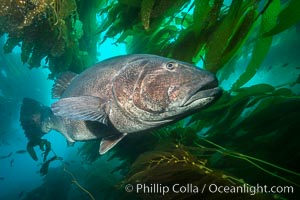
Giant black sea bass, endangered species, reaching up to 8' in length and 500 lbs, amid giant kelp forest.
Species: Giant black sea bass, Stereolepis gigas
Location: Catalina Island, California
Image ID: 33354
Species: Giant black sea bass, Stereolepis gigas
Location: Catalina Island, California
Image ID: 33354

Spanish shawl nudibranch, Flabellinopsis iodinea, Midriff Islands, Sea of Cortez.
Species: Spanish shawl nudibranch, Flabellinopsis iodinea
Location: Islas San Lorenzo, Baja California, Mexico
Image ID: 40471
Species: Spanish shawl nudibranch, Flabellinopsis iodinea
Location: Islas San Lorenzo, Baja California, Mexico
Image ID: 40471

Dendronotus iris swimming nudibranch, Browning Pass, Vancouver Island.
Species: Dendronotus iris
Location: British Columbia, Canada
Image ID: 35275
Species: Dendronotus iris
Location: British Columbia, Canada
Image ID: 35275

Eye-to-eye with a brilliantly-colored Spanish shawl nudibranch, Flabellinopsis iodinea, San Diego.
Species: Spanish shawl nudibranch, Flabellinopsis iodinea
Location: San Diego, California
Image ID: 37290
Species: Spanish shawl nudibranch, Flabellinopsis iodinea
Location: San Diego, California
Image ID: 37290

Kelp fronds showing pneumatocysts, bouyant gas-filled bubble-like structures which float the kelp plant off the ocean bottom toward the surface, where it will spread to form a roof-like canopy.
Species: Giant kelp, Macrocystis pyrifera
Location: San Clemente Island, California
Image ID: 38498
Species: Giant kelp, Macrocystis pyrifera
Location: San Clemente Island, California
Image ID: 38498

Three Giant Black Sea Bass in a Courtship Posture, Hovering One Above the Other in Kelp at Catalina Island. In summer months, black seabass gather in kelp forests in California to form mating aggregations. Courtship behaviors include circling of pairs of giant sea bass, production of booming sounds by presumed males, and nudging of females by males in what is though to be an effort to encourage spawning.
Species: Giant black sea bass, Stereolepis gigas
Location: Catalina Island, California
Image ID: 39434
Species: Giant black sea bass, Stereolepis gigas
Location: Catalina Island, California
Image ID: 39434
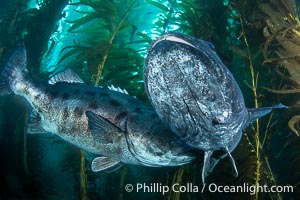
A male giant sea bass nudges a female giant sea bass to encourage spawning as they swim in a tight circle. This courting pair of giant sea bass is deep in the kelp forest at Catalina Island. In summer months, giant sea bass gather in kelp forests in California to form courtship and mating aggregations, eventually leading to spawning.
Species: Giant black sea bass, Stereolepis gigas
Location: Catalina Island, California
Image ID: 39435
Species: Giant black sea bass, Stereolepis gigas
Location: Catalina Island, California
Image ID: 39435

Closeup Portrait of the Face of a Giant Black Sea Bass, showing parasitic sea lice. These parasites find their nutrition from the skin and blood of the host giant sea bass. Smaller fishes such as senoritas and wrasses will commonly clean the sea lice off the giant sea bass.
Species: Giant black sea bass, Stereolepis gigas
Location: Catalina Island, California
Image ID: 39436
Species: Giant black sea bass, Stereolepis gigas
Location: Catalina Island, California
Image ID: 39436
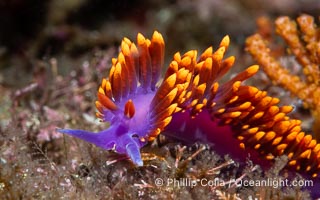
Spanish shawl nudibranch, Flabellinopsis iodinea, Midriff Islands, Sea of Cortez.
Species: Spanish shawl nudibranch, Flabellinopsis iodinea
Location: Islas San Lorenzo, Baja California, Mexico
Image ID: 40474
Species: Spanish shawl nudibranch, Flabellinopsis iodinea
Location: Islas San Lorenzo, Baja California, Mexico
Image ID: 40474

Three giant black sea bass, gathering in a mating/courtship aggregation amid kelp forest at Catalina Island. In summer months, black seabass gather in kelp forests in California to form mating aggregations. Courtship behaviors include circling of pairs of giant sea bass, production of booming sounds by presumed males, and nudging of females by males in what is though to be an effort to encourage spawning.
Species: Giant black sea bass, Stereolepis gigas
Location: Catalina Island, California
Image ID: 33355
Species: Giant black sea bass, Stereolepis gigas
Location: Catalina Island, California
Image ID: 33355

Giant Black Sea Bass with Unique Pattern of Black Spots at Catalina Island. The giant sea bass is an endangered species reaching up to 8' in length and 500 lbs, amid giant kelp forest.
Species: Giant black sea bass, Stereolepis gigas
Location: Catalina Island, California
Image ID: 33356
Species: Giant black sea bass, Stereolepis gigas
Location: Catalina Island, California
Image ID: 33356
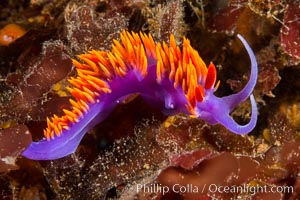
Spanish shawl nudibranch.
Species: Purple aeolis, Spanish shawl, Spanish shawl nudibranch, Flabellina iodinea, Flabellinopsis iodinea
Location: San Diego, California
Image ID: 34196
Species: Purple aeolis, Spanish shawl, Spanish shawl nudibranch, Flabellina iodinea, Flabellinopsis iodinea
Location: San Diego, California
Image ID: 34196

Orange Peel Nudibranch, Tochuina gigantea, Browning Pass, Vancouver Island.
Species: Orange peel nudibranch, Tochuina gigantea
Location: British Columbia, Canada
Image ID: 35259
Species: Orange peel nudibranch, Tochuina gigantea
Location: British Columbia, Canada
Image ID: 35259

Red Nudibranch, Dendronotus rufus, Browning Pass, Vancouver Island.
Species: Red nudibranch, Dendronotus rufus
Location: British Columbia, Canada
Image ID: 35271
Species: Red nudibranch, Dendronotus rufus
Location: British Columbia, Canada
Image ID: 35271
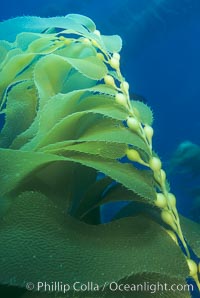
Kelp frond showing pneumatocysts.
Species: Giant kelp, Macrocystis pyrifera
Location: Santa Barbara Island, California
Image ID: 02435
Species: Giant kelp, Macrocystis pyrifera
Location: Santa Barbara Island, California
Image ID: 02435
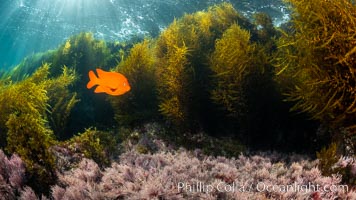
Garibaldi and Marine Algae, Coronado Islands, Mexico.
Location: Coronado Islands (Islas Coronado), Baja California, Mexico
Image ID: 36490
Location: Coronado Islands (Islas Coronado), Baja California, Mexico
Image ID: 36490

Sargassum and Marine Algae, Coronado Islands, Mexico.
Location: Coronado Islands (Islas Coronado), Baja California, Mexico
Image ID: 36491
Location: Coronado Islands (Islas Coronado), Baja California, Mexico
Image ID: 36491
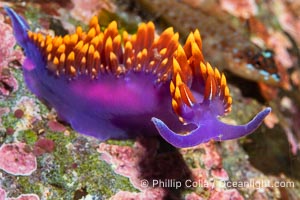
Spanish shawl nudibranch, Flabellinopsis iodinea, Midriff Islands, Sea of Cortez.
Species: Spanish shawl nudibranch, Flabellinopsis iodinea
Location: Islas San Lorenzo, Baja California, Mexico
Image ID: 40469
Species: Spanish shawl nudibranch, Flabellinopsis iodinea
Location: Islas San Lorenzo, Baja California, Mexico
Image ID: 40469
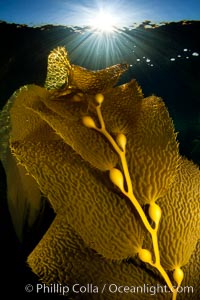
Kelp fronds and pneumatocysts. Pneumatocysts, gas-filled bladders, float the kelp plant off the ocean bottom toward the surface and sunlight, where the leaf-like blades and stipes of the kelp plant grow fastest. Giant kelp can grow up to 2' in a single day given optimal conditions. Epic submarine forests of kelp grow throughout California's Southern Channel Islands.
Species: Giant kelp, Macrocystis pyrifera
Location: San Clemente Island, California
Image ID: 25396
Species: Giant kelp, Macrocystis pyrifera
Location: San Clemente Island, California
Image ID: 25396

Kelp fronds and pneumatocysts. Pneumatocysts, gas-filled bladders, float the kelp off the ocean bottom toward the surface and sunlight, where the leaf-like blades and stipes of the kelp plant grow fastest. Catalina Island, California.
Species: Giant kelp, Macrocystis pyrifera
Location: Catalina Island, California
Image ID: 37282
Species: Giant kelp, Macrocystis pyrifera
Location: Catalina Island, California
Image ID: 37282

Spanish shawl nudibranch.
Species: Purple aeolis, Spanish shawl, Spanish shawl nudibranch, Flabellina iodinea, Flabellinopsis iodinea
Location: San Diego, California
Image ID: 34198
Species: Purple aeolis, Spanish shawl, Spanish shawl nudibranch, Flabellina iodinea, Flabellinopsis iodinea
Location: San Diego, California
Image ID: 34198

Pyrosome in Kelp Forest, Santa Barbara Island.
Species: Pyrosome, Pyrosoma
Location: Santa Barbara Island, California
Image ID: 35826
Species: Pyrosome, Pyrosoma
Location: Santa Barbara Island, California
Image ID: 35826

Kelp fronds showing pneumatocysts, bouyant gas-filled bubble-like structures which float the kelp plant off the ocean bottom toward the surface, where it will spread to form a roof-like canopy.
Location: Santa Barbara Island, California
Image ID: 35827
Location: Santa Barbara Island, California
Image ID: 35827